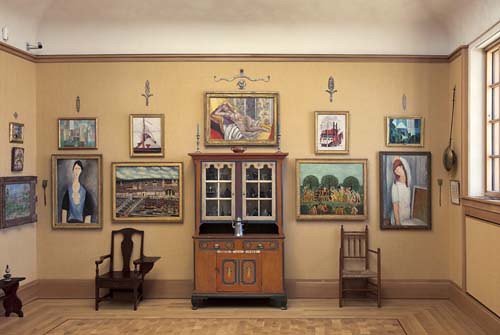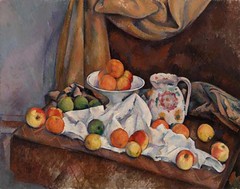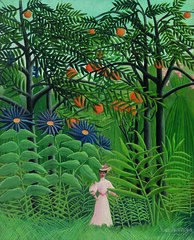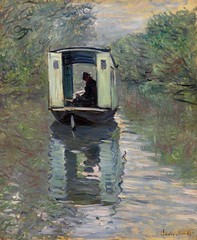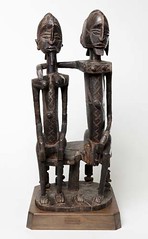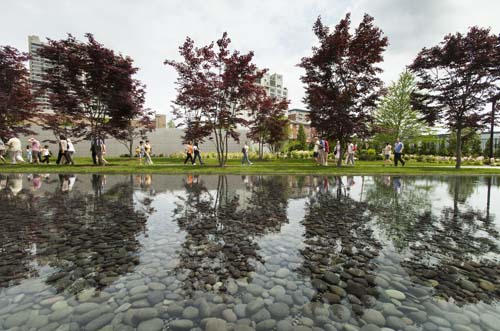A Review of The Barnes Foundation at its New Philadelphia Home
Continuing the Conversation:
A Review of The Barnes Foundation at its New Philadelphia Home
By Mary Wise
Room 18, east wall. The Barnes Foundation, Philadelphia. Photo: © 2012 The Barnes Foundation
A museum is a museum is a museum – until we pass through the path moving us inside the walls of The Barnes Foundation’s new home on the Ben Franklin Parkway in Center City, Philadelphia. Enveloped by high walls, the artfully constructed building within a garden, a concept designed by architects Billie Tsien and Tod Williams, immediately boasts of intellectual mystery and charm.
Though beyond those garden walls the city pulses with its usual fervor, all thoughts of that world melt away and is immediately replaced with the calm bubblings of a growing ardor one can only recognize as the anticipation of greatness. Upon approach, I was met by a large metal sculpture tipping the building’s beautifully still reflecting pool. The piece, raised high into the air above, seemed a marker, a promise of something grand. And the building itself, patterned with a multidimensional façade reminiscent of cubist art, became a tapestry to accent the powerful design of this essential garden. So we walked, my friend and I, down the tree-lined path noticing the loud and constant sound of streaming water, which seemed to come from nowhere. It beckoned us to stop and just be for a moment, nestled within this garden sanctuary, centering ourselves within our bodies before venturing on beyond the grand wooden doors of The Barnes Collection’s new home.
Most know Dr. Albert C. Barnes was a man who obsessively acquired and arranged brilliant works of art. Many are even aware that he made the millions to do it through his invention of Argyrol, an antiseptic silver compound that, still frequently used today, treats and prevents numerous ailments, including infant blindness. Few, though, realize that Barnes was first and foremost an educational pioneer, having developed his ideology from those of William James, George Santayana, and John Dewey. And that focus on education, along with his passion for art, is what drove him to create. He believed that learning through experience was essential, and he designed his collection in an effort to expand the public’s thinking. He wanted art to be accessible to everyone and for everyone to come away from viewing art with a profound sense of new understanding, not just of the artist’s work but of life itself. Through art, he believed, we could learn to see everything in a vastly different light.
Amazingly, those he employed needed only about 6 of the 8 hours in their day to complete their work. Barnes, instead of allowing the time to be wasted or increasing their workload, took that as an opportunity to educate. He began requiring his workers to attend classes during the remaining hours of their workdays.
This concept was the impetus that drove him to carefully craft his many rooms of strategically placed paintings and artifacts. And this concept is what had many up in arms at the idea of moving his masterpiece from the Lower Merion mansion and gardens he built as its home to its current Philadelphia residence, a setting that promised to be starkly different from the original. Many believed that moving such a collection would inevitably alter its integrity, and Barnes’ vision, in a devastating way. In fact, when established in 1922, Barnes decreed that upon his death this collection must remain exactly as he crafted it. However, as a result of zoning restrictions and low funding, the foundation’s board of trustees made the difficult but necessary decision to make the move.
They did not, however, decide to alter the arrangement by even a millimeter. Those involved spent painstaking hours measuring the exact space between every one of the works. The integrity, they said, would be preserved and even enhanced, which is something all involved believed was exactly in line with Barnes’ educational philosophy and would have, therefore, made the man proud.
As promised, upon the highly anticipated unveiling of this new home on May 19th 2012, much of the public’s intense consternation was not only quelled but reversed. This building, the grounds, and the gallery not only uphold his original collection’s integrity, it intensifies it, adding new layers to the already mind-altering experience. Both my friend and I came away from the visit with a new understanding of art, history, and yes, even the world. We felt completely energized and elated throughout our visit and for days after. I sit here writing this days past our trip still thinking, almost obsessively, about my experience, about the art work, about the artists, about the arrangements and pairing, and about Barnes himself. I am simply and completely in awe and have already planned my return and am plotting to become a founding member.
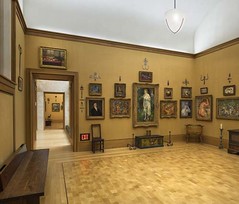 Walking through the gallery, I felt as though I was entering someone’s home. The setting is intimate, subdued, and because the ticketing is scaffolded, the space is breathable and alive. The large undressed windows were created to allow in only 17% of the natural light, so the work can be viewed organically. Each element of this setting is essential. Unlike the traditional museum which allows elbow room between each work of art in order to emphasize each piece’s singularity, Barnes piled art upon art to emphasize their commonality and to create, in and of itself, a museum that is truly its own work of art.
Walking through the gallery, I felt as though I was entering someone’s home. The setting is intimate, subdued, and because the ticketing is scaffolded, the space is breathable and alive. The large undressed windows were created to allow in only 17% of the natural light, so the work can be viewed organically. Each element of this setting is essential. Unlike the traditional museum which allows elbow room between each work of art in order to emphasize each piece’s singularity, Barnes piled art upon art to emphasize their commonality and to create, in and of itself, a museum that is truly its own work of art.
Each painting included in the collection is an amazing, titillating microcosm of the artist’s rendering of a moment in time. Barnes, however, saw the threads that weave them all together into an inseparable fabric. And we step into this web, bringing with us our own thread, our own schema, and leave not having added to the collection but having the collection added to us, warmly wrapping us in this new way of seeing.
To this end, he combined artists such as Mattise, Soutin, Cezanne, Renior, Rousseau, Miro, Picasso, Daumier, and Van Gogh, to name only a few, with metalwork decorations, hinges, and cages, with wooden cabinets, bureaus, and chairs, with ceramic and glass vases and cups, pewter candlesticks and teapots, and artifacts that range from 3000 BC Egyptian hieroglyphs to 20th century African sculptures. Barnes aimed and succeeded in crafting a collection that continued the conversation the original artists began. Each work of art speaks to each other through concept, color, contour, and rhythm. The 2 dimensional paintings accented by the 3 dimensional objects also bring us into the conversation by placing us in the art. We inhabit the room, the newly constructed artwork, and therefore become part of the threads woven throughout and become part of the conversation. The reality of each piece is driven into us because they are tangible, because they are alive and speaking. The room, though silent to our ears, is full of amazing chatter – so much so that it is almost overwhelming. Where does one begin? And the answer is anywhere. Let your own thread guide you, and then plan to return because the conversation will continue. There will always be much, much more to be said.
As with most museums, a very easily maneuvered audio tour, is a welcomed enhancement. This aids our understanding of every aspect of the collection and its home. Unlike most museums, however, the building includes a rich library and The Foundation offers numerous lectures and art education courses to the public. Each of these furthers the conversation between the art, and furthers the educational philosophy of its creator.
In order to fully process all we’ve absorbed, however, we need time to reflect. The architects, remaining true to Barnes’ ideology, not only created a building within a garden, they also crafted a garden within a building. This intimately small and quiet glass room, including trees and greenery, provides a sanctuary for one to momentarily pause again, just as we did in the outer garden before entering. This moment, taken at any time, is a needed breath, not just of literal fresh air, but of spiritual and emotional renewal. We center, again, within our bodies. We gel and solidify, we reorganize and meld all that we’ve encountered, all that we’ve learned, with ourselves. Again, again, again, the threads continue – through art, through history, through man-made objects, through nature, and through our individual selves. The threads will stay with us. This is what art is meant to do. It is meant to hold us together in times of dismay. It is meant to fill us with energy for life. It is meant to move us, to guide us, to change the way we understand and relate to life. It is meant to connect us to our world, to each other, to ourselves.
In every way, and unlike most other museums, The Barnes Foundation honors this purpose. The clarity with which all involved see Dr. Albert C. Barnes’s vision, and the clarity with which all involved see the purpose of art, is rendered majestically throughout every aspect of the collection’s new home.
The Barnes Foundation is more alive today than ever before. Threading the old conversation with the new, it continues breathing as if just born. If you visited it in its original home, make the time to revisit it in its new setting. Join the work’s continued conversation. The grand experience will become part of you.

